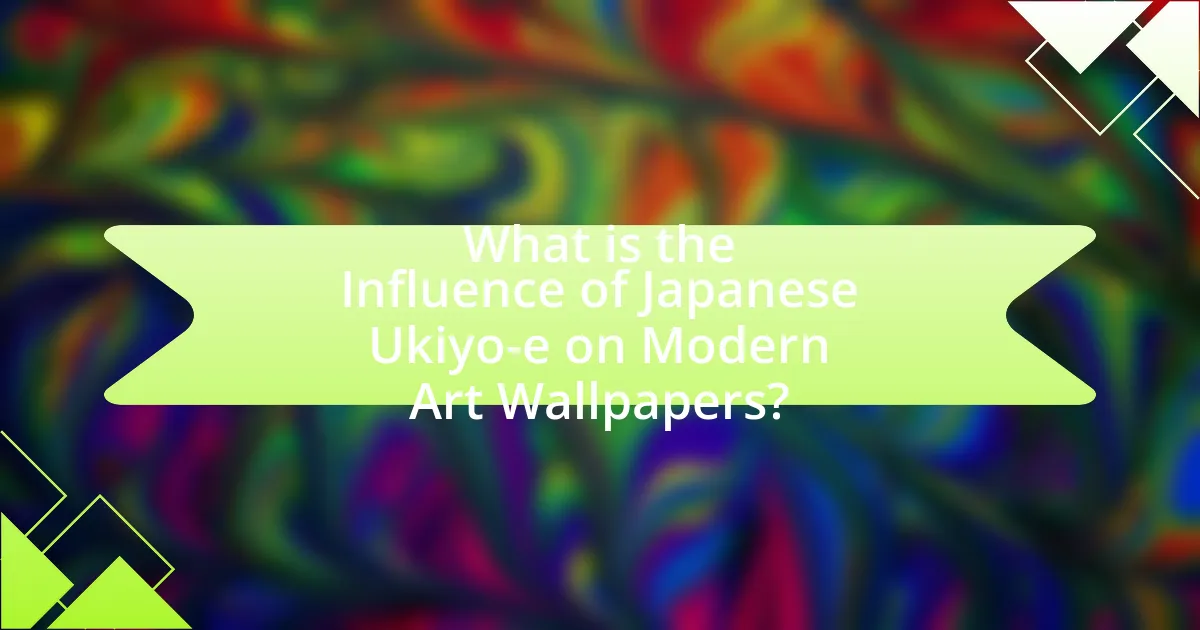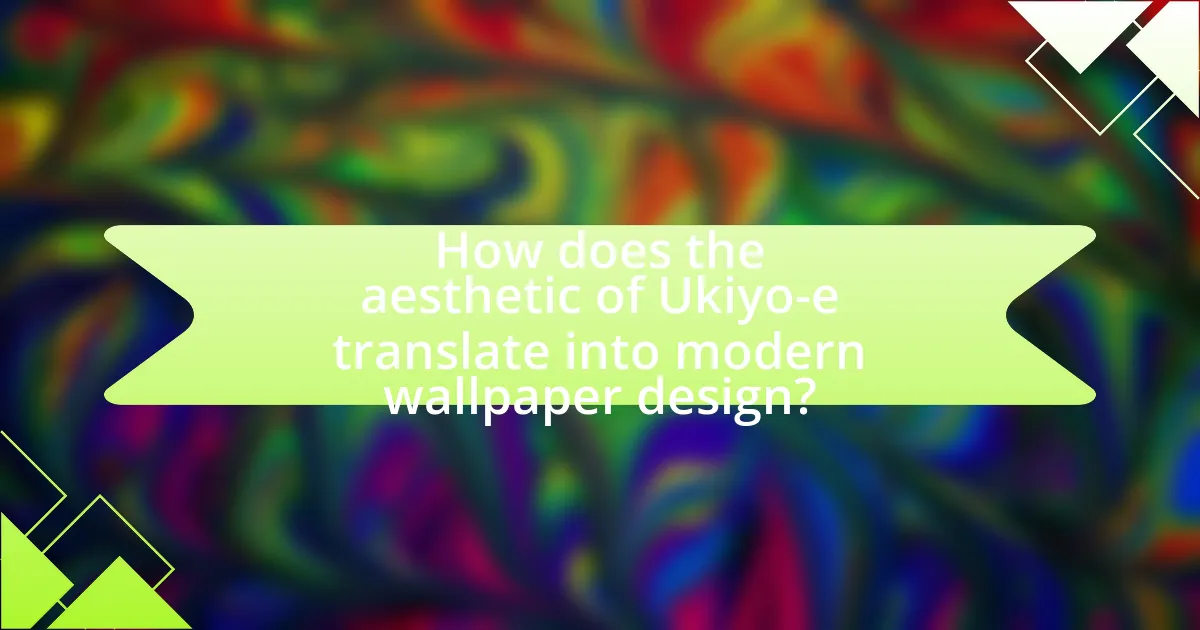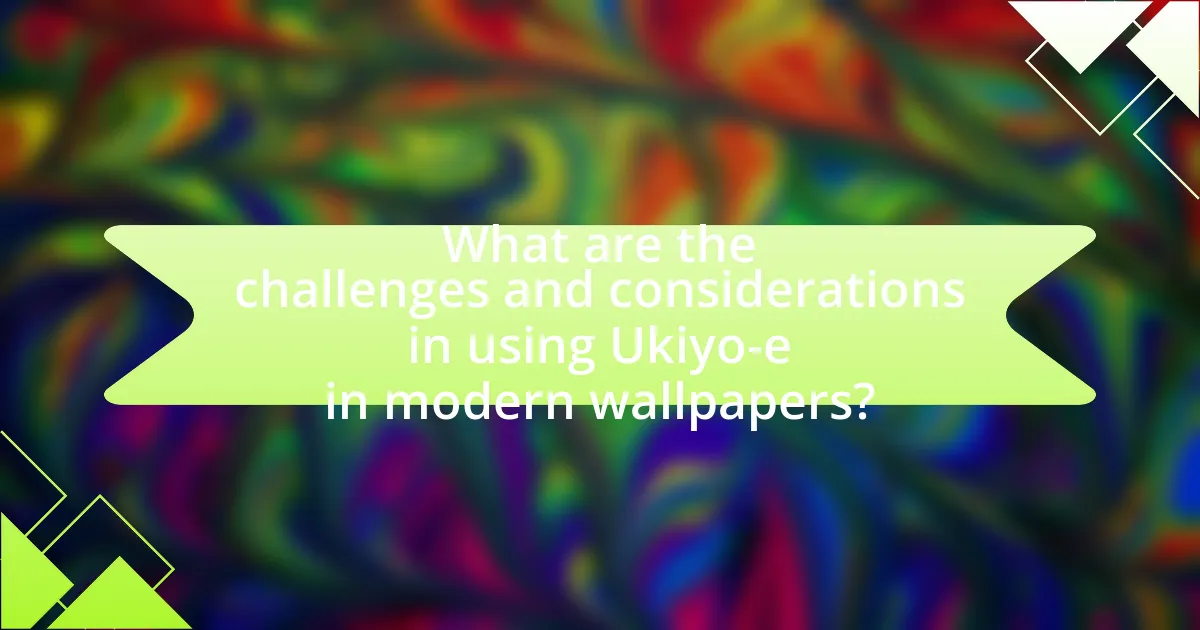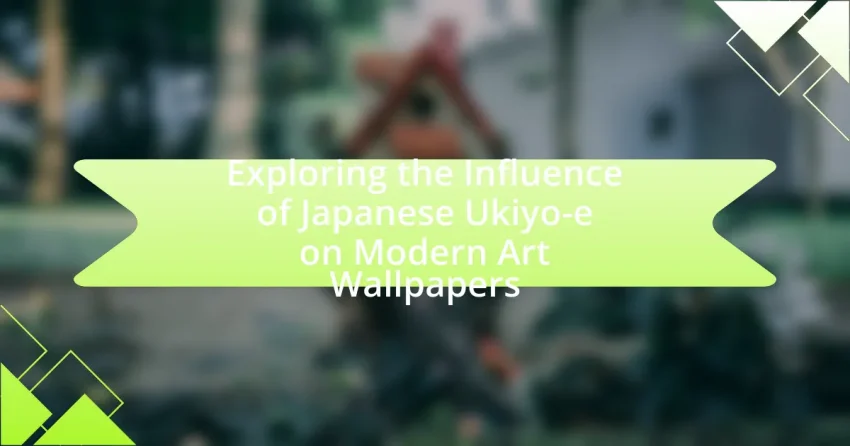The article examines the significant influence of Japanese Ukiyo-e on modern art wallpapers, highlighting its distinctive aesthetics characterized by bold colors, intricate patterns, and themes of nature and daily life. It traces the origins of Ukiyo-e during the Edo period and its evolution through notable artists like Hokusai and Hiroshige, whose works have inspired contemporary wallpaper designs. Key characteristics of Ukiyo-e prints, their impact on Western art movements, and the integration of traditional motifs into modern wallpaper aesthetics are discussed, along with the emotional responses and cultural appreciation they evoke in consumers. The article also addresses challenges related to cultural appropriation and copyright issues, providing best practices for incorporating Ukiyo-e into modern interior design.

What is the Influence of Japanese Ukiyo-e on Modern Art Wallpapers?
Japanese Ukiyo-e has significantly influenced modern art wallpapers through its distinctive aesthetics, characterized by bold colors, intricate patterns, and themes of nature and daily life. This influence is evident in the adoption of similar visual elements in contemporary wallpaper designs, which often incorporate flat perspectives and stylized representations reminiscent of Ukiyo-e prints. For instance, the use of floral motifs and landscapes in modern wallpapers can be traced back to the iconic works of Ukiyo-e artists like Hokusai and Hiroshige, who popularized these themes in the 18th and 19th centuries. Additionally, the integration of Japanese design principles, such as asymmetry and simplicity, has led to a more harmonious and balanced approach in modern wallpaper aesthetics, reflecting the enduring legacy of Ukiyo-e in contemporary interior design.
How did Ukiyo-e originate and evolve over time?
Ukiyo-e originated in the Edo period of Japan (1603-1868) as a genre of woodblock prints and paintings that depicted the “floating world,” which included scenes of landscapes, kabuki actors, and beautiful women. This art form evolved from earlier styles of painting and was influenced by the rise of a merchant class that sought affordable art for decoration and entertainment.
Over time, Ukiyo-e developed through the contributions of notable artists such as Hokusai and Hiroshige, who introduced innovative techniques and perspectives, enhancing the visual appeal and emotional depth of the prints. The introduction of color printing in the 18th century further expanded its popularity, allowing for more vibrant and intricate designs.
By the late 19th century, Ukiyo-e began to decline due to the influence of Western art and modernization in Japan, but its legacy persisted, influencing various art movements globally, including Impressionism and modern graphic design. The historical significance of Ukiyo-e is evident in its lasting impact on contemporary art forms, including wallpapers that draw inspiration from its aesthetic qualities.
What are the key characteristics of Ukiyo-e prints?
Ukiyo-e prints are characterized by their vibrant colors, intricate designs, and depictions of everyday life and landscapes in Edo-period Japan. These woodblock prints often feature subjects such as kabuki actors, beautiful women, and scenic views, showcasing the ukiyo (floating world) aesthetic. The technique involves multiple woodblocks for different colors, allowing for detailed and layered imagery. Historical evidence indicates that Ukiyo-e emerged in the 17th century and significantly influenced Western art movements, particularly Impressionism, due to their unique perspectives and use of color.
Who were the prominent artists in the Ukiyo-e movement?
The prominent artists in the Ukiyo-e movement include Katsushika Hokusai, Utagawa Hiroshige, and Utagawa Kuniyoshi. Katsushika Hokusai is renowned for his iconic woodblock print “The Great Wave off Kanagawa,” which exemplifies the movement’s focus on landscapes and nature. Utagawa Hiroshige is celebrated for his series “The Fifty-Three Stations of the Tōkaidō,” showcasing the beauty of travel and scenery in Japan. Utagawa Kuniyoshi is known for his dynamic and imaginative prints, often depicting warriors and mythical creatures. These artists significantly contributed to the development and popularity of Ukiyo-e, influencing both Japanese and Western art.
Why is Ukiyo-e significant in the context of modern art?
Ukiyo-e is significant in the context of modern art because it profoundly influenced Western artists in the late 19th and early 20th centuries, particularly during the Impressionist and Post-Impressionist movements. Artists such as Vincent van Gogh and Claude Monet drew inspiration from Ukiyo-e’s unique composition, use of color, and emphasis on everyday life, which led to a shift in artistic perspectives and techniques in Europe. The introduction of Japanese woodblock prints to the West showcased new aesthetic values, such as flat areas of color and bold outlines, which challenged traditional Western art norms and contributed to the development of modern art styles.
How did Ukiyo-e influence Western art movements?
Ukiyo-e significantly influenced Western art movements, particularly Impressionism and Post-Impressionism, by introducing new aesthetic principles and techniques. Artists such as Vincent van Gogh and Claude Monet were inspired by the bold colors, flat perspectives, and unique compositions found in Ukiyo-e prints. For instance, van Gogh famously collected Japanese prints and incorporated their stylistic elements into his own work, evident in pieces like “The Courtesan” and “Flowering Plum Tree.” This cross-cultural exchange led to a departure from traditional Western artistic conventions, fostering a greater appreciation for color and form, which ultimately shaped the trajectory of modern art.
What themes and motifs from Ukiyo-e are prevalent in modern art?
Themes and motifs from Ukiyo-e that are prevalent in modern art include nature, beauty, and the transient nature of life. Modern artists often draw inspiration from Ukiyo-e’s depiction of landscapes, floral patterns, and the human figure, reflecting a similar appreciation for aesthetics and the fleeting moments of existence. For instance, the use of bold colors and flat perspectives in contemporary graphic design can be traced back to the stylistic choices of Ukiyo-e artists like Hokusai and Hiroshige, who emphasized the beauty of everyday life and natural scenes. This influence is evident in various modern art forms, including digital art and wallpaper design, where the integration of these themes creates a dialogue between traditional Japanese art and contemporary visual culture.
What are the connections between Ukiyo-e and modern art wallpapers?
Ukiyo-e, a genre of Japanese woodblock prints, significantly influences modern art wallpapers through its aesthetic principles and thematic elements. The vibrant colors, intricate patterns, and focus on nature and everyday life found in Ukiyo-e are mirrored in contemporary wallpaper designs, which often incorporate similar motifs and color palettes. For instance, artists like Katsushika Hokusai and Utagawa Hiroshige have inspired modern designers to adopt their stylistic approaches, leading to wallpapers that celebrate natural beauty and cultural narratives. This connection is evident in the resurgence of floral and landscape patterns in modern wallpapers, which echo the visual language of Ukiyo-e, thereby bridging traditional Japanese art with contemporary interior design.
How have designers incorporated Ukiyo-e elements into wallpaper designs?
Designers have incorporated Ukiyo-e elements into wallpaper designs by utilizing traditional motifs, color palettes, and compositional techniques characteristic of this Japanese art form. For instance, patterns featuring iconic subjects such as landscapes, flora, and fauna, often depicted in a flat, stylized manner, are prevalent in modern wallpaper collections. Additionally, the use of vibrant colors and intricate details reminiscent of Ukiyo-e prints enhances the visual appeal of contemporary wallpapers. This integration reflects a growing trend in design that seeks to blend historical artistry with modern aesthetics, as seen in collections by brands like Scanteak and Graham & Brown, which explicitly reference Ukiyo-e in their designs.
What are some examples of modern wallpapers inspired by Ukiyo-e?
Modern wallpapers inspired by Ukiyo-e include designs that replicate the iconic woodblock printing style, featuring elements such as landscapes, floral patterns, and traditional Japanese motifs. For instance, companies like Spoonflower offer wallpapers that showcase designs reminiscent of Hokusai’s “The Great Wave” and Hiroshige’s scenic views. Additionally, brands like Graham & Brown have collections that incorporate Ukiyo-e aesthetics, blending contemporary colors with classic imagery. These wallpapers not only pay homage to the historical art form but also adapt its themes for modern interior design, reflecting the ongoing influence of Ukiyo-e in contemporary art.

How does the aesthetic of Ukiyo-e translate into modern wallpaper design?
The aesthetic of Ukiyo-e translates into modern wallpaper design through the incorporation of its characteristic elements such as bold colors, intricate patterns, and nature-inspired motifs. Modern wallpaper designers often draw inspiration from the fluid lines and dynamic compositions found in Ukiyo-e prints, which depict scenes of landscapes, flora, and fauna. For instance, the use of vibrant color palettes reminiscent of traditional woodblock printing techniques enhances the visual appeal of contemporary wallpapers. Additionally, the emphasis on storytelling and cultural themes in Ukiyo-e is reflected in modern designs that aim to evoke a sense of place and history, creating immersive environments in interior spaces. This connection is evident in the works of designers who specifically reference Ukiyo-e artists like Hokusai and Hiroshige, integrating their iconic imagery into wallpaper collections that celebrate both heritage and modern aesthetics.
What design principles from Ukiyo-e are utilized in wallpaper?
Ukiyo-e design principles utilized in wallpaper include the use of bold colors, asymmetrical compositions, and nature-inspired motifs. These principles are evident in modern wallpapers that often feature vibrant hues and dynamic layouts, reflecting the aesthetic of Ukiyo-e prints. For instance, the emphasis on natural elements, such as flowers and landscapes, mirrors the traditional Ukiyo-e focus on the beauty of nature, which was a central theme in works by artists like Hokusai and Hiroshige. Additionally, the incorporation of negative space in wallpaper designs echoes the Ukiyo-e technique of creating balance and harmony within the artwork.
How do color palettes from Ukiyo-e influence modern wallpaper aesthetics?
Color palettes from Ukiyo-e significantly influence modern wallpaper aesthetics by introducing vibrant, harmonious color combinations that evoke emotional responses. These traditional Japanese woodblock prints often feature a limited yet striking palette, utilizing colors derived from natural pigments, which modern designers adopt to create visually appealing and culturally rich wallpaper designs. For instance, the use of indigo, vermilion, and soft pastels in Ukiyo-e has inspired contemporary wallpaper patterns that aim to replicate the serene and balanced atmosphere characteristic of these artworks. This influence is evident in the trend of incorporating nature-inspired motifs and color schemes that reflect the aesthetic principles of Ukiyo-e, thereby enhancing the overall ambiance of modern interiors.
What patterns and compositions are derived from Ukiyo-e for wallpaper design?
Ukiyo-e has significantly influenced wallpaper design through its distinctive patterns and compositions, characterized by flowing lines, natural motifs, and vibrant colors. Common patterns derived from Ukiyo-e include floral designs, landscapes, and scenes of daily life, often featuring elements such as cherry blossoms, waves, and geishas. These compositions are typically asymmetrical, reflecting the Japanese aesthetic of balance and harmony. The use of negative space in Ukiyo-e also translates into wallpaper design, allowing for a sense of openness and tranquility. This influence is evident in contemporary wallpaper collections that incorporate traditional Ukiyo-e themes, demonstrating the enduring legacy of this art form in modern interior design.
Why do consumers gravitate towards Ukiyo-e inspired wallpapers?
Consumers gravitate towards Ukiyo-e inspired wallpapers due to their unique aesthetic appeal and cultural significance. The intricate designs and vibrant colors characteristic of Ukiyo-e art evoke a sense of beauty and nostalgia, connecting modern spaces to traditional Japanese culture. Additionally, the historical context of Ukiyo-e, which flourished during the Edo period, adds depth and authenticity to the decor, making it a popular choice for those seeking to create a distinctive atmosphere in their homes. The rising interest in Japanese art and design in contemporary interior decor further reinforces this trend, as consumers appreciate the blend of artistry and craftsmanship that Ukiyo-e wallpapers offer.
What emotional responses do Ukiyo-e wallpapers evoke in consumers?
Ukiyo-e wallpapers evoke a sense of nostalgia and tranquility in consumers. The intricate designs and historical significance of Ukiyo-e art often remind individuals of Japan’s rich cultural heritage, fostering feelings of appreciation and connection to tradition. Additionally, the serene landscapes and harmonious color palettes commonly found in Ukiyo-e prints can induce relaxation and calmness, enhancing the overall ambiance of a space. Studies have shown that art with historical context, like Ukiyo-e, can elicit emotional responses tied to cultural identity and personal memories, reinforcing the emotional impact these wallpapers have on consumers.
How does cultural appreciation play a role in the popularity of these wallpapers?
Cultural appreciation significantly enhances the popularity of wallpapers inspired by Japanese Ukiyo-e by fostering a deeper connection between consumers and the art form. This appreciation allows individuals to recognize the historical and aesthetic value of Ukiyo-e, which dates back to the Edo period and features intricate designs that reflect Japanese culture and nature. As a result, modern art wallpapers that incorporate these elements resonate with consumers seeking authenticity and cultural richness in their home decor. The growing interest in global art forms, coupled with the rise of cultural awareness, has led to an increased demand for wallpapers that celebrate and honor traditional art, making them more appealing in contemporary settings.

What are the challenges and considerations in using Ukiyo-e in modern wallpapers?
The challenges and considerations in using Ukiyo-e in modern wallpapers include cultural appropriation, authenticity, and reproduction quality. Cultural appropriation arises when designers use Ukiyo-e without understanding its historical significance, potentially leading to misrepresentation. Authenticity is crucial, as modern adaptations may dilute the original artistic intent and context of Ukiyo-e, which was deeply rooted in Edo-period Japan. Additionally, reproduction quality poses a challenge; achieving the intricate details and vibrant colors characteristic of Ukiyo-e requires advanced printing techniques, which may not always be feasible. These factors must be carefully navigated to respect the art form while integrating it into contemporary design.
How do copyright issues affect the use of Ukiyo-e designs?
Copyright issues significantly restrict the use of Ukiyo-e designs, as these artworks are often protected under copyright laws that prevent unauthorized reproduction. Many Ukiyo-e prints, created by artists such as Katsushika Hokusai and Utagawa Hiroshige, are still under copyright protection, particularly if they were produced after 1923, which is the year when many works transitioned into public domain status. The legal framework surrounding copyright means that using these designs without permission can lead to legal repercussions, including lawsuits and financial penalties. Therefore, artists and designers must navigate these copyright laws carefully to avoid infringing on the rights of the original creators or their estates.
What are the ethical considerations in reproducing traditional art for commercial use?
Reproducing traditional art for commercial use raises significant ethical considerations, primarily concerning cultural appropriation, artist rights, and the preservation of cultural heritage. Cultural appropriation occurs when elements of a culture are used without permission or understanding, often leading to misrepresentation and exploitation of the original culture. For instance, the reproduction of Japanese Ukiyo-e prints in commercial products without consent from the originating culture can undermine the cultural significance and context of the artwork.
Additionally, the rights of the original artists or their descendants must be respected, as many traditional artworks are tied to specific communities and their histories. The unauthorized reproduction can lead to financial loss for these communities, as they may not benefit from the commercial success of their cultural expressions. Furthermore, ethical reproduction should involve collaboration with the original culture’s representatives to ensure that the art is used respectfully and in a manner that honors its origins.
In summary, ethical considerations in reproducing traditional art for commercial use include avoiding cultural appropriation, respecting artist rights, and ensuring the preservation of cultural heritage through collaborative practices.
What are the best practices for incorporating Ukiyo-e into modern interior design?
The best practices for incorporating Ukiyo-e into modern interior design include selecting authentic prints, using them as focal points, and blending them with contemporary elements. Authentic Ukiyo-e prints, which date back to the Edo period, provide historical significance and aesthetic appeal, making them ideal for feature walls or framed art pieces. When used as focal points, these prints can enhance the overall design by drawing attention and creating a conversation starter. Additionally, pairing Ukiyo-e with modern furniture and decor can create a harmonious balance between traditional and contemporary styles, ensuring that the space feels cohesive and thoughtfully designed. This approach not only respects the cultural heritage of Ukiyo-e but also allows for creative expression in modern interiors.
How can homeowners effectively use Ukiyo-e wallpapers in their spaces?
Homeowners can effectively use Ukiyo-e wallpapers by selecting designs that complement their existing decor and create a focal point in the room. For instance, large-scale Ukiyo-e prints featuring landscapes or figures can serve as statement walls, enhancing the aesthetic appeal of living rooms or bedrooms. Additionally, homeowners should consider the color palette of the Ukiyo-e wallpaper to ensure it harmonizes with furniture and accessories, as these traditional Japanese artworks often feature vibrant colors that can energize a space. The historical significance of Ukiyo-e, which dates back to the 17th century, adds cultural depth to the decor, making it not only visually striking but also meaningful. By thoughtfully integrating these wallpapers, homeowners can transform their spaces into unique environments that reflect both artistic heritage and personal style.
What tips can designers follow to blend Ukiyo-e with contemporary styles?
Designers can blend Ukiyo-e with contemporary styles by incorporating traditional elements such as bold outlines, flat colors, and nature motifs into modern compositions. This approach allows for a seamless integration of the historical aesthetic with current design trends. For instance, using Ukiyo-e’s characteristic wave patterns or floral designs as backgrounds in minimalist layouts can create a striking contrast that appeals to contemporary sensibilities. Additionally, experimenting with scale and abstraction can help reinterpret classic Ukiyo-e subjects in a fresh context, making them relevant to today’s audience. This method is supported by the ongoing popularity of Japanese art influences in global design, as seen in various exhibitions and collaborations that highlight the fusion of traditional and modern aesthetics.
